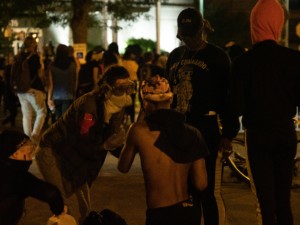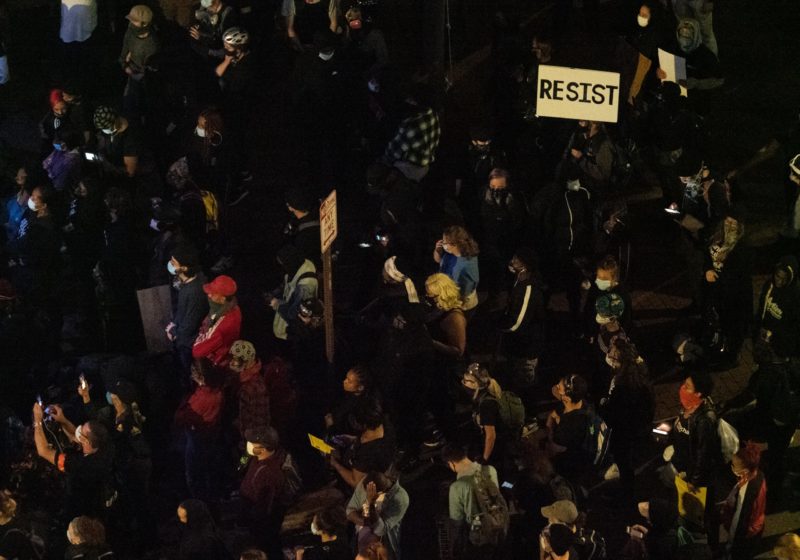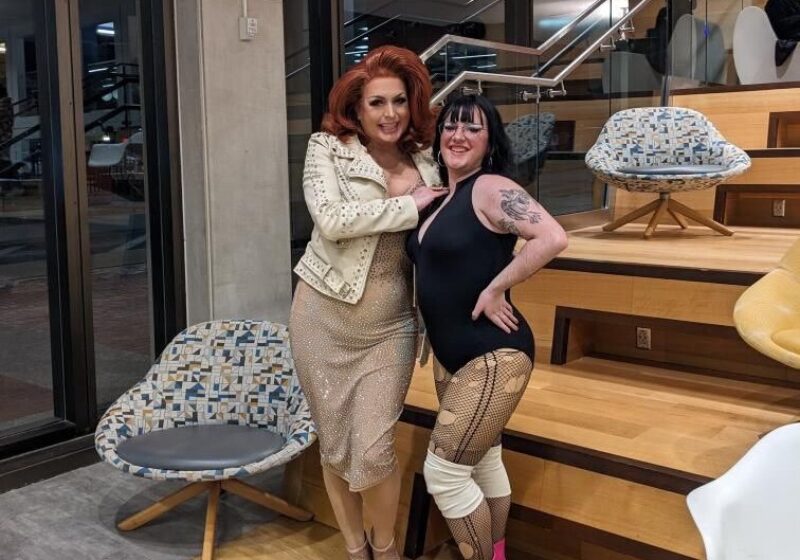It’s a few hours to midnight at Martin Luther King Jr. Memorial Park. Music plays as a few thousand people of different ages, races, and ethnicities gather on the grass. Pizza and snacks are up for grabs, a few people are smoking and drinking, flying drones and clenched fists decorate the air, and people are passing out phone numbers.
Sam Cooke’s “Change is Going to Come” accompanies the crowd’s silent moment before they start moving. Joe Prude walks up to the stage, looks out at a vast crowd, tears falling down his face and remarks, “This right here, it’s beautiful.”
If you were looking from a distance, you’d think this was some kind of celebration or sporting event. But people don’t bring face masks, bicycle helmets, swimming goggles, umbrellas, and homemade shields to a celebration. This community mobilization is a symptom of the deadly pandemic that’s existed long before COVID-19: systemic racism.
The protest is a sadly familiar scene. About four months ago, protestors swarmed the streets all over the country — and the world — expressing outrage and sorrow after GEORGE FLOYD was killed by police in Minneapolis on May 25. About two months earlier, on March 30, DANIEL PRUDE died seven days after being restrained by Rochester police. After five months, the video of how PRUDE died was discovered and released by his family.
Rage and indignation are palpably felt in Rochester’s air.
Heading toward East Avenue, protestors with shields organize themselves into a barrier between other protestors, and police clad in riot gear.
At this point you’d wonder whether most protestors are aware of the dangers they face. Whether mothers with their toddlers, immunocompromised elders, and people in wheelchairs feel the looming threat of COVID-19 at a protest where social distancing is virtually impossible. Whether they’re aware that the police will at any time declare a peaceful protest an unlawful assembly and start shooting a barrage of pepper balls, rubber bullets, and tear gas at them.

A volunteer medic treats a protestor after being sprayed with pepper spray outside of the Rochester Public Safety building on September 3.
They were brought here by an overwhelming consensus that DANIEL PRUDE, GEORGE FLOYD, BREONNA TAYLOR, ATATIANA JEFFERSON, AURA ROSSER, STEPHON CLARK, PHILANDO CASTILLE, and the many more Black people killed by police deserve justice, and that the expectation of peace in the face of injustice is unjust.
They believe that cities, nightlife, and roads should be interrupted when law enforcement propagates systemic racism and kills Black people with impunity.
The protesters advance to pierce the streets of Rochester with chants, songs, and raised fists. On East Avenue, drivers honk in solidarity as protestors chant, “No justice, no peace. Fuck these racist ass police!” Park Avenue residents leave their homes and join the crowd as they chant, “Out of your homes, into the streets!” Court Street echoes with thousands chanting “Say his name: DANIEL PRUDE.” Chestnut Street and Strong Museum hear the call for Mayor Lovely Warren, Rochester Police Department Chief La’Ron Singletary, and Deputy Mayor James Smith to resign after covering up PRUDE’s death for five months. The protesters say, “We demand that Mark Vaughn, Troy Taladay, Francisco Santiago, Andrew Specksgoor, Josiah Harris, Sergeant Michael Magri, and Paul Ricotta are fired and prosecuted for killing PRUDE.”
They refuse to accept that a system that shoots unarmed Jacob Blakes but protects armed Kyle Rittenhouses is a just one. They’re convinced that the disproportionate killing of Black people by police is a deliberate result of government policy, a design etched into the foundations of this country centuries ago. They resolve to burst the complacent, privileged bubble of white silence. They’re angry that the Rochester Police Department killed another Black man that it was oath-bound to protect. They know that PRUDE wasn’t killed by police officers so much as he was murdered by his country: a country that endows power rooted in white supremacy to cops, and is designed to uphold the systematic mistreatment of Black people.
They stop by the Butterfly Garden at Strong Museum, the “Black Lives Matter! Black Lives Matter!” chants getting louder and louder. Standing under #DefundThePolice signs, the protesters understand that had anyone been dispatched to help PRUDE — a man who was in desperate need of mental health assistance — other than someone with a weapon and state-sanctioned power over others, the outcome would have been significantly different. PRUDE would be with his family today.
These protests could be paralleled with the children’s book “Horton Hears a Who!” Much like Horton, the protesters believe that “a person’s a person, no matter how small.”
They believe that individual protestors — tiny specks of dust among a field of clovers — can sing, play instruments, dance, and raise their fists to make their voices heard. That if every Who resident shouts, “We are here! We are here!” their sound waves could break the clouds till change comes.
More than ten days after the first protest, they haven’t stopped. Every night, the declaration is the same: “It is our duty to fight for our freedom, and it is our duty to win!”





